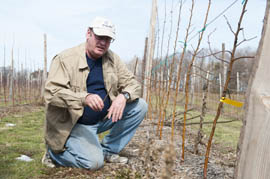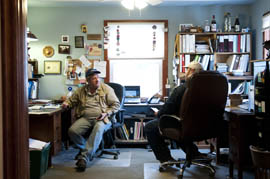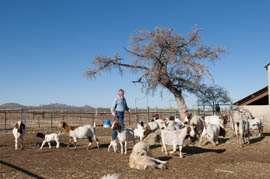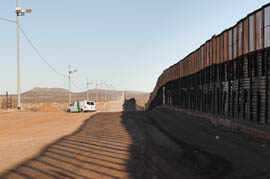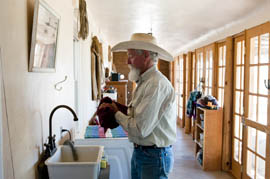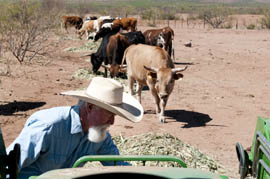Cronkite News has moved to a new home at cronkitenews.azpbs.org. Use this site to search archives from 2011 to May 2015. You can search the new site for current stories.
Immigration reform poses challenges for farmers along two borders
There is no fruit on the trees in New York in March but Jim Bittner is busy making phone calls and talking to buyers for the upcoming growing season. When he walks outside, the cool air from Lake Ontario bites at his cheeks. If the sky is clear, he might be able to see Toronto, Canada, from one of his apple orchards.
More than 2,200 miles away, rancher Dennis Moroney steps onto his porch and into the dry heat of southern Arizona. The 160 cattle he tends are in the mountains for the winter, waiting until the first green mesquite beans appear in the flat land. As he points out the boundaries of his property, “from the peak of that mountain, over the ridge, to that slope,” he can also point to a long black line dividing the landscape in the distance. It’s a small section the border fence between the United States and Mexico.
Bittner and Moroney each owns land that comes within a few miles of a U.S. border. Bittner’s 400 acres of fruit orchards outside of Appleton, N.Y., include several lots that touch Lake Ontario, which serves as a small portion of the nearly 4,000-mile border that the United States shares with Canada. The border with Mexico is only 20 miles away from Moroney’s ranch just outside of Bisbee, Ariz. Although his 34,000 acre ranch does not touch the border, it is visible from his property and he has had frequent contact with Border Patrol agents as well as unauthorized immigrants who cross over from Mexico.
Immigration laws passed by Congress will inevitably impact Moroney and Bittner, as well as others living along the nation’s borders. They will be on the front lines if a new immigration reform act authorizes more access to private property for patrols, more boots on the ground, more surveillance drones in the air and more regulation of agricultural workers in the fields.
Attracted by border, culture
Moroney bought his property in 2002, after a nine-year dispute with the U.S. Forest Service prompted him to sell a ranch outside of Prescott, Ariz. Though his current ranch is smaller than his previous one, Moroney said the proximity to the border was one factor that attracted him to the area.
“We liked the idea of being close to Mexico, of having the opportunity to immerse ourselves in both cultures,” Moroney said, “A lot of the cowboy tradition is also Spanish-style vaquero tradition.”
Though Moroney grew up in Phoenix, he spent summers on his grandfather’s ranch in northern Arkansas and after a lesson on shoeing horses, he was drawn to a life spent outdoors.
“I had worked part of my time in high school in my dad’s law office, filing things, doing different errands and what not, and I knew it was not really what I wanted to do,” Moroney says. “But there was a long path to get where we are now because we didn’t have a family ranch to inherit.”
While attending Phoenix College in 1971 for the first of the four degrees he holds in agriculture and animal science, Moroney met his wife Deb in a modern dance class. After marrying in 1972, the two spent 14 years in Washington’s Yakima Valley, where Moroney taught high school agriculture. In 1992, they returned to Arizona to begin ranching land in Prescott. Ten years later, they moved to the ranch outside of Bisbee where they raised two children, Allie, 21, and Kevin, 18, while Dennis tended to the ranch and Deb worked in a nearby clinic.
Moroney was aware of the immigrant crossings in the area—the activity had actually helped lower the price of the land, making it more affordable—but he believed they could handle it.
“We said, ‘We’ll deal with this. We dealt with the Forest Service, we can deal with anything.’ That was our conversation to ourselves,” Moroney says, “We didn’t realize how much of an impact it was, to the land and to the livestock. But we found out.”
On the eastern side of the ranch, there is an unpaved road running from north to south. It is a hotspot for crossings. When the Moroneys first looked at the property, they saw a swath of trash, 20 feet wide and stretching 500 feet down the road. Moroney believes that immigrants had pre-arranged pickups in the area, leaving behind anything they could do without as they crammed into vans headed for town.
Since then, Moroney has encountered many people on his land. During a high point in migration, he recalls opening the door in the morning and walking out to a dozen gaunt, hollow-eyed people looking for water and food. They had been told it was a three-hour walk to Tucson, but three nights later they were only as far as Moroney’s ranch, 20 miles from the border. Tucson is another 70 miles away.
“You’d be going along on horseback and we’re looking for cows, and you hear a human sound. Like this person is crying or sobbing or whimpering,” Moroney says. “You’d look and underneath the mesquite tree there’s somebody hunkered over and the soles of their feet are blistered off. They have no water. The group that they were with had to leave them behind. It’s like, how can we help you? ‘Call the Border Patrol.’ Or, ‘Just help me.’”
Today there are still backpacks, pieces of clothing and trash throughout the ranch, some of it partially buried by the dust that blows through the area. Moroney has found calves with tin cans stuck on their feet, their hooves growing into the shape of the rusted metal. After several cleanup attempts, he has stopped picking up what remains.
Only a boat full of Canadians
For Jim Bittner, the only encounter with unauthorized immigrants happened when he was a kid. A small boat full of Canadians found themselves on the shores of Olcott Beach, N.Y., the town where Jim and his friends spent most of their time. They had gotten lost on Lake Ontario and needed directions back to Canada.
“Nobody swims Lake Ontario, we don’t have those issues,” Bittner says. “Maybe I’m being a little naïve, but from where I sit, the only time people were smuggling things across from Canada was during Prohibition for Canadian whiskey and beer.”
Bittner has lived next to the lake for his entire life, save for the three years he spent away at Cornell University studying agriculture. There he met his wife Margo and the two moved back to the area that Jim grew up in to start working in agriculture. Like Moroney, Bittner did not have a family farm to inherit, though his father had kept a garden and some livestock for a number of years. Bittner entered a partnership with a dairy farmer for nine years and when the partner retired he switched to running a fruit farm. A friend and economist who believed the apple business was profitable persuaded him to give it a try.
After a few false starts, Bittner had what he calls a banner year in 1990 when he rented 100 acres of tree fruit from Gerber, the baby food company. After the one-year lease on the property was up, he was approached by a local family and offered a partnership in their operation, Singer Farms. In 1991, Bittner began farming what would grow into 400 acres of tree fruit, about half of which is apples with the remainder divided up between stone fruits like peaches, cherries, nectarines, and apricots
Today, Bittner owns the majority of Singer farms, while the daughter of the original owner retains a small share. Bittner manages the day-to- day operations of the farm while Margo runs a winery down the road. Their sons Kevin, 30, and David, 26, work for Jim at the farm while their daughter Janet, 26, is Margo’s assistant at the winery.
“Right now we’re growing fruit trees,” Bittner says. “It’s not that I love growing fruit, I love agriculture. If I could make a living doing beef cattle or hogs or corn, I would do that.”
Bittner has seen an evolution in the Border Patrol presence along the northern border. His farm runs along the main road closest to the lake, State Highway 18. Though he has no childhood memories of Border Patrol in the area, Bittner says that in 2011 Border Patrol cars would pass by three to four times a day, as well as a helicopter overhead once a day.
“What they’re doing here and why they’re here was always a joke here,” Bittner says. “It’s not like we had problems with immigrants or people sneaking across the border here, it’s not like the Mexican border.”
There is a large population of immigrants living in the area, many of whom work on dairy or fruit farms. Bittner employs an average of 50 in one season, many originally from Mexico. Though he does not participate in any temporary foreign worker programs, he says his workers all have legal documentation. After an Immigration and Customs Enforcement audit five years ago, Bittner was notified that five out of the 82 workers he employed over a three-year period had falsified documents.
“I am to look at this documentation and if it’s not obviously fraudulent, I’m to accept it at face value,” Bittner says. “That is my responsibility [to determine validity].”
According to the Immigration and Nationality Act, employers are required to “verify the identity and employment eligibility of all individuals hired in the United States after November 6, 1986.” When Immigration and Customs Enforcement audits a business, the employer has three days to provide I-9 forms for each worker they have employed in the last three years. The I-9 is used by the federal government to ensure a person is authorized to work in the United States.
Failure to comply could result in fines ranging from $110 to $1,100 for each incorrect form. If officials determine that the employer knowingly hired and continues to hire undocumented workers, fines range from $375 to $16,000 for each worker.
After Bittner’s audit, the five employees with fraudulent documents never returned to the farm.
The Border Patrol presence in the area has resulted in a cautious migrant community that is wary of being profiled. According to Bittner, many workers avoid leaving the farm even if that means sending someone into town to collect their groceries or cash their checks.
“We now have trucks that drive around from camp to camp selling food to the workers because the workers do not want to go to the grocery store,” Bittner says. “They know they’re going to get stopped and harassed.”
Bittner struggles between wanting to keep his head down versus the cultural expectations of his workers.
“In their culture back in Mexico, the boss is probably the richest guy in town, and if he tells law enforcement to go away, the law enforcement will go away,” Bittner says. “They really cannot fathom the fact that, as an employer, my hands are tied. I can’t do anything about Border Patrol. And quite frankly, I’m afraid to say anything because I don’t want to get harassed by them either.”
Living in ‘the zone’
Moroney lives in what he refers to as “the zone,” a corridor between the fence and the Border Patrol checkpoints that begin around the town of Tombstone, Arizona, 30 miles north of the border. Though he jokes that the large presence of agents in the area is positive economic stimulus for the region, he believes that there is a surplus of law enforcement.
“They bought a lot of trucks, they’ve hired a lot of people, they’re paying a lot of wages.” Moroney says. “But they don’t have any work to do. We see them sleeping in their trucks on the end of the road.”
Moroney’s first experience with Border Patrol occurred when he was teaching high school in central Washington in the 1980s. Early one morning on the way to work, he drove past a large peach orchard. Border Patrol was conducting a raid and workers were fleeing left and right. The next day in class, many of his students had parents who had not returned home from work.
“It completely changed my view of migrant farm working, immigration and Border Patrol,” Moroney says.
Today, Moroney has frequent contact with Border Patrol agents. Though gates throughout the ranch are locked, Border Patrol has its own set of locks that are threaded through Moroney’s, allowing them to enter the property as needed.
“In earlier years, they would be chasing somebody and they would run through a fence or a gate,” he says. “And we’d see Border Patrol trucks trailing 50 feet of barbed wire on either side of their fenders.”
Moroney recalls one incident when he and Deb were sleeping outside during the summer — the house is not air-conditioned and the night air is cooler so they sleep on cots in the yard. Just after 2 a.m., the yard suddenly was filled with Border Patrol trucks and trailers racing through. Though Moroney shouted at them, agents waited until their search was complete to return to the main house to speak with Moroney.
“Normally when you come to somebody’s house, you stop and knock on the door and ask for that help,” Moroney says. “You don’t just barge into their private property. They went on about their business and it was fine but that serves as an example of what all too often is the dark side of Border Patrol behavior.”
Not every encounter Moroney has had with agents is negative. Moroney recalls incidents where agents have stopped to assist with broken vehicles or stopped traffic for cattle crossings on the ranch. Moroney and his neighbors have held meetings with Border Patrol to discuss ranch etiquette, reminding agents to close gates or ask permission to cross private property. The locks installed on gates were part of these plans. But difficulties persist, including figuring out which Border Patrol station is responsible for the ranch and dealing with a constant rotation of new agents.
“I guess we were in the Cochise [County] Triangle or something and no one claimed us,” Moroney says. “Or they just kept moving things around.”
Canada like a state
To Bittner, Canada has always felt like another state instead of a different country. He remembers frequent family vacations to Toronto or school trips to the flower garden in Niagara Falls, Ontario. Nowadays he and Margo visit Canada about six times a year, typically for festivals or trade shows.
“I used to go double that,” Bittner says. “If it was easier, I’m sure we’d go more. But, we don’t unless I have a full day that I can devote to it.”
Bittner has more than travel links with Canada; he frequently ships product across the border. After heavy losses from hail storms in 1997 and 1998, Bittner “rolled the dice” on an investment in processed peaches. The gamble paid off and he now ships most of his peaches to Canada for processing. In recent years, he’s had challenges finding truckers willing to cross the border.
“I have truckers that refuse to go to Canada,” Bittner says. “And I have other truckers that know how the system works and have a little more patience and no problem going into Canada.”
Routes have also become longer. The quickest route to Michigan for Bittner’s products used to be a short-cut through Canada, but long wait times at the border have made it impossible.
“That took an hour off the trip. It’s great roads going up through Canada,” Bittner says. “But all of the truckers that I deal with, that haul my product for me, stay on the American side. They go all the way up around through Cleveland, up and around, it’s another hour trip to go to northern Michigan… It adds mileage, it adds cost but the interesting thing is it’s not getting into Canada. It’s getting back into the United States. It’s the hassle.”
A 2010 Government Accountability Office report found that the northern border suffered from a lack of agency coordination between the many law enforcement partners in the area, including local, federal, state and Canadian agencies. That year, Border Patrol reported that only 32 of the nearly 4,000 mile northern border had “an acceptable level of security.” It has since been increased to 69 miles. The GAO recommended that the Department of Homeland Security increase their oversight of agencies to ensure efficient communication. But in a follow up report in 2013, the GAO found that this oversight had not been properly established and that some agencies may be overlapping in their duties.
According to the DHS, the border shared by the United States and Canada is the longest common border in the world. The DHS’s 2012 Northern Border Strategy highlights the unique relationship between the two countries, with more than 300,000 people and $1.5 billion in trade crossing the U.S.-Canada border daily.
Rather than illegal crossings, the primary security concern in the area is terrorism. This issue was highlighted in an April 2013 incident in which the Royal Canadian Mounted Police and the FBI were instrumental in stopping a planned terrorist attack on a commuter train bound from Toronto to New York.
Bittner acknowledges that there is a potential for terrorism along the northern border but he says he isn’t too concerned. For him, the Canadian border is a “technicality.”
“I joke with people that it just happens to be where the Niagara River cut through. That just happens to be the border,” Bittner says. “[Canada and the U.S.] are very, very similar.”
Bittner would like immigration reform that includes a path to citizenship. The 2013 Border Security Act, a leading bipartisan proposal for immigration reform, includes a path for immigrants without legal status but only after it has been determined that the border is secure and there is a “mandatory employment verification system” in place. For agricultural workers, the act includes a provision allowing current undocumented farm works to obtain legal status if they have “made a substantial prior commitment to agricultural work in the United States”
Until recently, Bittner didn’t believe this kind of reform was possible. He started to explore ways to use fewer foreign workers, to find ways to entice domestic labor to agricultural work that has historically been filled by workers from abroad. For Bittner, it’s all about compromise.
“Cooler heads have to prevail, some honest discussions have to occur without people screaming at each other and get past the amnesty, the law breakers, and all this sort of thing,” Bittner says. “This country was built on immigrants. There is a way of doing this. Let’s get it done.”
A new reality
It’s been about five years since Dennis Moroney’s ranch has had a problem with immigrant crossings. For Moroney, there was a noticeable decrease in immigrant activity and Border Patrol incidents around late 2008. He believes the economic downturn in the United States played a part. This mirrors the findings of a 2013 GAO report, which reported a 69 percent decrease in apprehensions on the southern border between 2006 and 2011. Many of the travelers Moroney met in the mid-2000s told him stories of leaving their job in the United States for a weekend funeral in Mexico, only to have to illegally cross the border to return to their jobs the following week. Others were young people on their fourth or fifth crossing, hoping they wouldn’t be caught and returned to Mexico again.
“We would ask people why they would put themselves in such danger when they could just do it legally,” Moroney says. “And they would say, ‘It takes 15 years to get the permits… We can’t wait. There are no jobs at home. We’re hungry, our family is suffering.’”
In addition to immigration reform, the proposed 2013 Border Security Act calls for increased surveillance in “high risk” sectors along the southern border, defined as areas with over 30,000 apprehensions of individuals per year. The bill would appropriate $3 billion dollars to increase the number of Border Patrol agents and expand the use of drones and surveillance equipment.
Moroney would rather see a more welcoming relationship between the United States and Mexico, similar to the relationship that the U.S. has with Canada. According to U.S. census data, Mexico is the country’s third largest trade partner behind Canada and China. While President Obama and Canadian Prime Minister Stephen Harper have worked together on a shared vision for security along the northern border, Moroney feels that international relations between the United States and Mexico are sour.
“My personal view is that our own government is not looking at this whole situation in a rational way,” Moroney says. “Working with Mexico to bring about a little more economic parity for the poor people would seem to have been a better mission for Hillary Clinton than shuttling around the Middle East where we don’t seem to have done a damn bit of good in my whole lifetime.”
Instead, Moroney says, the U.S. has poured their efforts into building up a wall to divide, rather than unite.
“When I was a kid, crossing the border meant firecrackers and when I was a bit older it meant being able to walk into a bar and buying a beer when you were 16 years old,” Moroney says. “To me, the border now… It’s a politically determined line that, much like a boundary between housing lots in a neighborhood, is related to land ownership and some history and culture differences. Essentially, the two sides of the border are the same piece of land, the same biological community.”
EDITOR’S NOTE: Cronkite Borderlands Initiative reporter Molly Smith interviewed and photographed farmer Jim Bittner in Appleton, N.Y., and rancher Dennis Moroney in Bisbee, Ariz., to chronicle their lives on two borders.

